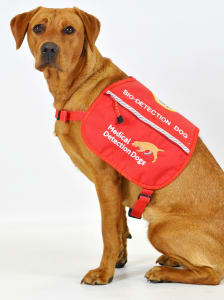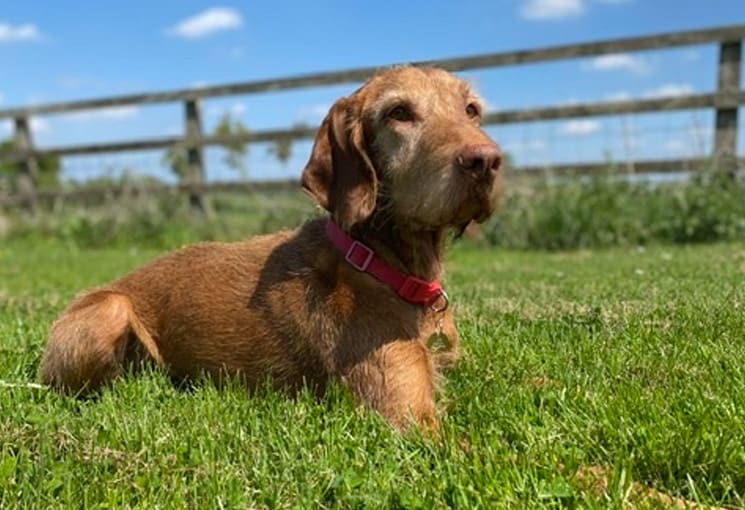Prostate cancer stinks. Figuratively and, well, literally. Humans can’t smell it, but dogs sure can. And get this: aggressive prostate cancer has its own smell, that dogs can distinguish! Earlier this year, PCF-funded researchers in the U.S. and UK published a study showing that medical detection dogs could discriminate – with high accuracy – between urine samples from men who have prostate cancer and men who don’t.
These cancer-sniffing canines are so good at what they do that it could lead to a revolution in prostate cancer detection. What’s their secret? Nobody knows! PCF-funded scientists are working furiously to unravel the mystery of how the dogs do this – and just what it is that they are smelling on the molecular level – so their success can be replicated on a much larger scale. In the meantime, we thought you might like to get to know some of these superdogs.
Florin is a six-year-old Fox Red Labrador. “She’s very self-contained, a very calm, studious dog,” says Claire Guest, psychologist, registered pet behaviorist, co-founder and Chief Scientific Officer of Medical Detection Dogs. Florin is one of four dogs living at Guest’s house, along with Tala, a big Yellow Lab; Asher, a rescue dog; and Iggy, a wire-haired Dachshund and the new recruit. In the back yard are Marley, a horse, and three chickens.

Florin does not always use her great powers for good: “She also uses her nose to find food when she shouldn’t,” says Guest. But she makes up for it by being a great snuggler. “I have a leather sofa, and she always lies on the back of it and curls around my neck. She did it since she was a baby.” When she’s not working or chilling on the couch, Florin loves long walks.
Daisy, a Yellow Labrador “with a beautiful temperament – very motivated to work,” is a legend in bio detection, and one of the first dogs Guest trained to sniff out cancer. In 2014, Daisy was awarded UK’s Blue Cross Medal for her pioneering work in the field of cancer detection: She sniffed more than 6,500 samples and correctly identified more than 550 cases of cancer! Sadly, she is no longer with us, but her legend lives on.
One of the people with cancer, whose life Daisy saved, was Claire Guest. Daisy had been trained to smell bladder cancer. “She immediately recognized cancer odor, and we very quickly identified that she could smell prostate cancer,” as well. “She worked for many years. During her training time, she started to behave differently around me. She kept jumping into my face, nudging at me,” and her behavior was so deliberate that it caused Guest to go to the doctor. “I was diagnosed with very early, very deep-seated breast cancer.” After a lumpectomy, radiotherapy and hormone treatment, “I’m here 10 years later to tell the tale. If attention had not been drawn to the cancer, it could have been a very different story.”
Daisy’s talent seems to run in the family: she is Florin’s aunt. Florin has big paws to fill!
Midas, age nine, is a Wire-Haired Hungarian Viszla. “She has an unusual personality,” says Guest. “She’s quite clingy, and slightly eccentric.” One of her favorite tricks is to jump up into an office chair as soon as someone leaves it. “Some visitors are met by a very different member of staff!”
Midas lives with a fosterer, who also has two horses. “She’s got lots of space and she’s very happy. Her fosterer dotes on her.” Midas loves her work. “We retire dogs when we feel the dog is no longer enjoying it,” but Midas shows no signs of slowing down.

Midas a Medical Detection Dog
Photo credit: MDD
On a typical day, like the 45 or so other bio detection dogs Guest’s team is training, Midas and Florin come to work in the morning, enjoy a nice walk and breakfast. Then they go to the training area, “meet up with their other doggie pals,” work for about half an hour, and take a break. To help their concentration and not overtax their noses and brains, the dogs “don’t work more than three times a day. It’s quite an easy life for them.”
Work, for these dogs, is not only fun; it’s rewarding! “Generally, we use food,” says Guest. “Some like a ball, although we tend not to give them a ball reward during their session. It might make them hot,” and make it more difficult for them to discriminate smells (if they’re panting from chasing the ball). “We use praise, too. These dogs are highly motivated to use their nose, so they get an inner reward, as well.” They just like sniffing! Guest also uses a clicker, which helps the dogs instantly know when they’ve gotten it right.
All the dogs live in family homes. “We have a no-kennel policy. They all have normal pet lives when they’re not working.”
How do they do it? When they’re working, the dogs are smelling urine, sweat, and other samples. Some of the samples are from people with cancer, and some are not – although this is subject to change: once, Guest’s team thought a dog, named Tangle, wrongly identified someone as having bladder cancer; it turns out, the dog was right, and was the first to identify kidney cancer instead! But how do these dogs know – and how does one teach dogs like Midas and Florin to communicate what they’re smelling?
Success starts by finding dogs who like a challenge. “It’s really important that the dogs enjoy their work,” says Guest. “The dog isn’t just rewarded for finding the positive (yes, there’s cancer). Dogs are rewarded for the correct answer.” This is a departure from how scent-discriminating dogs have traditionally been trained, which can make the dog “feel he hasn’t done his job if he can’t find the odor” and can also increase the likelihood of a false positive, as the dog is so eager to find something. “If the dog gets a reward for the correct answer (yes, there’s cancer, or no, there’s not), it removes anxiety, and teaches them the rules much better.”
Some dogs, Guest continues, “absolutely love problem-solving.” Some dogs – particularly hunting or working gun dogs, like Labs and Spaniels – love using their nose. “We also use rescue dogs: dogs that have gone into shelters for being too energetic or too lively often make really good working dogs for us.”
The key for medical detection is finding a dog with both these qualities in spades. “You could never turn a dog who didn’t have a knack for it into a real detection dog. If you threw the ball 100 times in long grass, the dog has to home in on the odor. You’ll hear the nose very rapidly sniffing. Some dogs, 100 times, they’ll go out and find it. But other dogs, if they can’t see it, will say, it’s not there. They don’t bother to use their nose. Some might find it three or four times and say, ‘Yeah, I’m done.’ You want the dog who will say, “Keep throwing it!”
Next – Part 2: Smells Like Cancer










